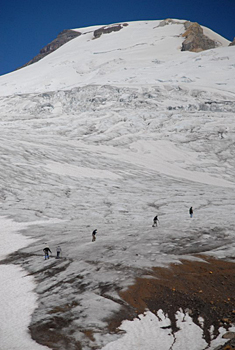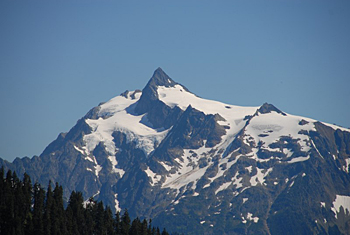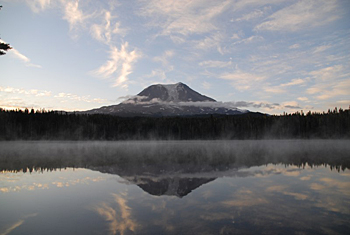
But O'Neal, who's spearheading a decade-long study monitoring glaciers in the Pacific Northwest, isn't motivated by instant results. In fact, it's the monumental challenge and scale of the systems he studies, he says, that he enjoys.
“There are as many as 10,000 glaciers in the Cascades region,” O'Neal said, “and realizing that as one person I can only study a few, or a few dozen, in my lifetime makes it a trick.
“A lot of time is spent trying to figure out exactly where the glaciers that you're studying were in recent history--primarily the last 200 years,” he added, describing the nature of the fieldwork that he, two colleagues and 10 students from UD's Department of Geography conducted on the Aug. 12-21 trip. “And that's no easy task.
“For the last 10,000 years, alpine glaciers in the mid latitudes in the northern hemisphere have fluctuated back and forth,” he said, “and what we're studying now are how changes in precipitation and temperatures over a span of years are affecting the larger valley glaciers in the region.”
Starting from the Canadian border and ending in Oregon, O'Neal's August expedition with Brian Hanson, glaciologist and chairperson of UD's Department of Geography; Daniel Leathers, climatologist and professor of geography at UD; and seven UD graduate and three undergraduate students, included visits to some of the larger valley glaciers in the Cascade range and tracked data being charted for the 10-year study.
Now in its second year, the monitoring process will include summertime field trips to Iceland, Greenland, Alsaka and the Canadian Rockies, as well, and will trace how patterns in precipitation and temperature affect glaciers over time.“One of the things that the Department of Geography specializes in is especially cold climates, so in this study we're trying to understand how glaciers vary naturally, and we're particularly interested in recent glacier fluctuation in the Cascades,” O'Neal said. “We're one of just a handful of groups working in that area of the country, so that makes the region all the more appealing.”
Adding that the study, at its conclusion, will leave some room for the growing debate over global warming, O'Neal emphasized that the primary goal is to better understand the natural variations of glaciers over time.
“Everybody has heard that glaciers are retreating,” he said, “and in a general sense that's true. But understanding how much glaciers have retreated and when and how they have retreated is very difficult, and the data is very complex. In our fieldwork, we're trying to understand how glaciers vary naturally. Glaciologists have observed--just in recent history--that these systems can advance by as much as 300 meters in a very short span of years, as they did in the 1980s. So knowing how and why they do this is vital for making any sweeping predictions of climate change.”
Given this scholarly angle, as well as the leisurely timeframe, the study, O'Neal said, allows for in-depth research and affords students the rare opportunity to take what they've learned beyond the classroom.
“If I'm excited about one thing, it's that students from our department are getting the opportunity to do something they'd probably never do on their own,” he said. “We camp at about 3,000 feet and hike every day to about 7,000 or 8,000 feet. Students get exposed to icy, alpine landscapes, and getting to these locations is no small feat. It's a physical challenge to study them on top of a mental challenge, and students get a real vision of what it means to be in these environments and why it's so hard to study them. At the end of two weeks, there are enough scrapes and bruises for me to be glad that I've limited the trip to 10 days and 10 students, but the value of the experience is lasting.”
Two independent projects, launched during the summer's trip, reflect this. One, by master's candidate Adam Goldstein, a geology major from Wayne, N.J., will examine how heavy deforestation affects local summertime mountain temperatures (and, by extension, glaciers). The other, by senior Janine Howard, an environmental conservation major from Ridgefield, Conn., will draw on data she collected this summer for a presentation she'll give with O'Neal at the annual conference of the Association of American Geographers in Boston next spring.
“Geography students at UD do work on ice and climate, so being involved in fieldwork is important for them, and in terms of their collaboration, we're going to look for National Science Foundation funding,” O'Neal said.Explaining the complex and long-term nature of the study, he added that most students who want to participate in the summertime field trips get the chance.
“There are warm periods, not unlike the one we're in now, that have occurred frequently on 100-year time scales during the last 10,000 years,” O'Neal said, “and part of what we want to understand is how often they occurred and how many times in the past few thousand years glaciers retreated to their farthest extent. That is the kind of information we are trying to establish even before we try to tweak out how recent patterns of precipitation and temperature have affected glaciers in the Cascades.”
Fitting data collected from the study into a larger framework of glacier research is an even bigger goal, he added.
“The Pacific Northwest is a small region of the planet, and relating our data to research conducted in other regions--there are tens of thousands of glaciers on earth--will be tricky,” O'Neal said.
“One of the things we do believe--and one of the reasons we are studying glaciers in the Pacific Northwest, where there are decades-old precipitation patterns that last--is that precipitation and temperature are equally important in affecting the larger valley glaciers in the Cascade Range. In a lot of regions, that's not true. But in the Pacific Northwest, the precipitation patterns tell at least half the story on how the glaciers out there behave. So the statement we can make from our research that hasn't been made before is that understanding the role precipitation plays on glaciers in Cascades region is critical,” he said.
As a larger framework gets laid and the science community draws further evidence for global warming, O'Neal said that having conclusive data will be especially useful.“I think that most of the people in this department would agree that if you look at the statistics of recent climate, the planet does seem to be warming,” he said. “But climate is the statistics of weather, and weather is noisy, and glaciers are poor proxies of climate change in general. They take a long time to respond. Their behavior is complicated and the natural variations of the systems are poorly understood. So while we hope that we're a contributor to the global thought that global warming is affecting glaciers, we are really gathering data with the intent that it will go to the scientific community to give us all better tools for understanding the natural variations of glacial systems.”
Article by Becca Hutchinson
Photos courtesy of Michael O'Neal




